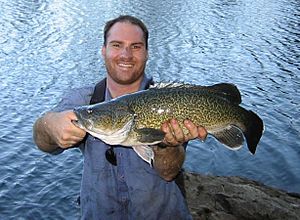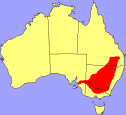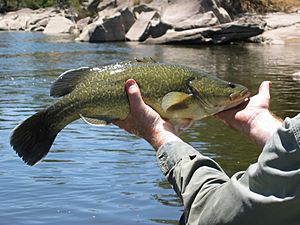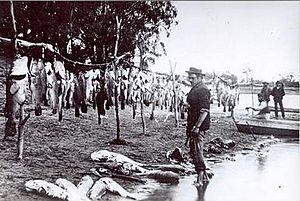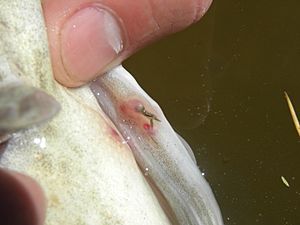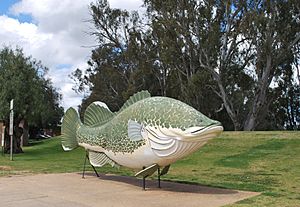Murray cod facts for kids
Quick facts for kids Murray cod |
|
|---|---|
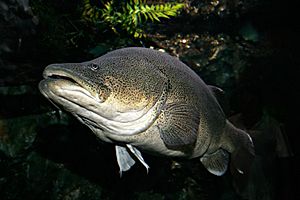 |
|
| Conservation status | |
| Scientific classification | |
| Genus: |
Maccullochella
|
| Species: |
peelii
|
| Synonyms | |
|
|
The Murray cod (Maccullochella peelii) is a very large freshwater fish found in Australia. It's a top predator in the Murray-Darling River system, which is Australia's biggest river network. Even though it's called a "cod," it's not related to the ocean cod found in the Northern Hemisphere.
The Murray cod is the largest fish that lives only in freshwater in Australia. It's also one of the biggest freshwater fish in the world! People sometimes call it by other names like greenfish or goodoo.
Its scientific name, Maccullochella peelii, comes from an early fish researcher named Allan Riverstone McCulloch. The "peelii" part refers to the Peel River, where the explorer Major Mitchell first described this fish.
Sadly, the number of Murray cod has dropped a lot since Europeans arrived in Australia. This is because of too much fishing, changes to rivers, and damage to their homes. Because of this, they are now a threatened species. Even so, they once lived in huge numbers across almost the entire Murray-Darling basin.
Murray cod live for a long time. Adult fish are carnivorous (meat-eaters). They eat things like shrimp, yabbies, other fish, and freshwater mussels. They are also very good parents. They lay their eggs in spring, usually inside hollow logs or on hard surfaces. The parents then guard the eggs. Murray cod are popular for fishing and are also raised in aquaculture farms. Many people in Australia also keep them as aquarium pets.
What Does a Murray Cod Look Like?
The Murray cod is a big fish that looks a bit like a grouper. It has a deep, long body that's round. Its head is wide and scooped, with a large mouth full of tiny, sharp teeth. Its lower jaw might stick out a little.
The spiny fin on its back is not very tall. It's partly separated from the soft, rounded fin behind it. All its soft fins—on its back, belly, and tail—are large and rounded. They are usually dark grey or black with clear white edges. Its big, rounded fins near its head are often the same color as its sides. The fins on its belly are large and angular, placed forward of the other fins. The white rays at the front of these belly fins split into two white threads. The belly fins themselves are usually clear white or cream.
Murray cod are white or cream on their bellies. Their backs and sides are usually yellowish-green to green. They have dark green, brown, or black spots and blotches. This makes them look marbled, sometimes like a leopard. Their color is brighter in fish from clear water. Smaller Murray cod from clear water often have very striking colors. Very large fish tend to be more speckled grey-green.
How Big Do Murray Cod Get?
Murray cod are truly big fish. Adult fish often grow to be 80 to 100 centimeters (about 31 to 39 inches) long. Some can grow much larger than 1 meter (over 3 feet). The biggest Murray cod ever recorded was over 1.8 meters (about 6 feet) long and weighed around 113 kilograms (about 250 pounds). Sadly, very large breeding fish are rare in the wild today because of too much fishing.
Murray Cod's Relatives
Murray cod are part of a pattern in Australian native fish. They have "lowland" species that live in slower, wider rivers, and "upland" species that prefer faster, higher-up river parts. Murray cod are mostly lowland fish. The endangered trout cod is the specialist upland species.
However, Murray cod are very adaptable. They can live quite far up into upland areas. Trout cod, on the other hand, used to live further down into the lowland areas before their numbers dropped. So, while there's a pattern, it's not always super clear.
Murray cod have also crossed the Great Dividing Range mountains. This happened through natural events where rivers changed course. This led to other types of "coastal cod." The most famous ones are the eastern freshwater cod in the Clarence River and the Mary River cod in the Mary River. Both of these are endangered but still exist. Sadly, coastal cod in the Richmond River and Brisbane River systems are now extinct.
Scientific Classification of Murray Cod
In the past, there was some confusion about how to classify Murray cod. In the 1800s, fishermen and scientists recognized two types of cod in the southern Murray-Darling basin: Murray cod and trout cod. But some scientists thought they were the same species.
Later, as trout cod numbers dropped, the difference became even less clear. In the 1970s, new genetic tests proved that trout cod were indeed a separate species. It also turned out that the original "Murray cod" specimen used for scientific description was actually a trout cod!
Because of scientific rules, the name M. macquariensis stayed with the trout cod. A new name, M. peelii, was given to the Murray cod. This name came from the Peel River, where a new example of the Murray cod was found. Since then, two more cod types have been identified as separate species: the eastern freshwater cod (M. ikei) and the Mary River cod (M. mariensis).
Where Do Murray Cod Live?
The Murray cod is named after the Murray River. This river is part of the Murray-Darling basin, which is Australia's biggest river system. The Murray cod naturally lives almost everywhere in the Murray-Darling basin. This includes the lower, flat areas and also higher-up areas. They can be found up to about 700 meters (2,300 feet) high in the southern part of the basin and up to 1,000 meters (3,300 feet) in the northern part.
This means Murray cod live in many different places. They can be in cool, clear, fast-flowing streams with rocky bottoms in the mountains. They also live in large, slow-moving, winding rivers in the wide, flat areas of the basin.
Sadly, Murray cod have disappeared from many of their upland homes. This is due to too much fishing, mud filling up rivers, dams blocking their paths, pollution, and sometimes, introduced trout that compete with young cod. Murray cod have also been introduced to other river systems, like the Cooper Basin in Queensland.
How Long Do Murray Cod Live?
Murray cod live for a very long time. This is common for many native freshwater fish in Australia. Living a long time helps them survive in Australia's changing environment. It means most adult fish will get to be part of at least one very good breeding event. These events often happen during very wet La Niña years and might only occur every 10 or 20 years.
Murray cod are the longest-living native freshwater fish in Australia. The oldest one found so far was 48 years old. Even bigger fish from the past suggest they can live much longer, perhaps 70 years or more!
What Do Murray Cod Eat?
The Murray cod is the top predator in the Murray-Darling basin rivers. It will eat almost anything smaller than itself. This includes other fish like smaller Murray cod, golden perch, silver perch, and even introduced fish like carp and goldfish. They also eat crustaceans such as yabbies, freshwater shrimp, and Murray crayfish.
While fish are eaten a lot by mature Murray cod in lowland rivers, crustaceans are usually their main food in natural conditions. In the past, they also commonly ate freshwater mussels. Murray cod have even been seen eating ducks, cormorants, freshwater turtles, water dragons, snakes, mice, and frogs.
People who fish for Murray cod at night with lures on the surface have learned something interesting. While Murray cod usually hide and wait for prey during the day, at night they become active hunters. They swim in shallow waters and often catch prey from the surface.
Murray Cod Life Cycle and Reproduction
Murray cod become old enough to breed when they are between four and six years old, usually around five. For wild river Murray cod, about 70% are ready to breed when they are 50 centimeters (about 20 inches) long. However, Murray cod in dams like Lake Mulwala grow faster. They don't become ready to breed until they are well over 60 centimeters (about 24 inches) long. This shows that the current fishing size limit of 50 cm might be too small. It should be increased so more fish can breed before they are caught.
Large female Murray cod, weighing 15 to 35 kilograms (35 to 80 pounds), are the most important for breeding. They produce the most eggs. Also, large females in most fish species produce bigger young with more food stored in their yolk sacs. They are also more experienced breeders and know the best ways to breed. All these things mean that the eggs from large female fish have a much better chance of surviving. So, the idea that "large Murray cod don't breed" is not true.
When female Murray cod first start breeding, they lay no more than 10,000 eggs. Very large females can lay as many as 80,000 to 90,000 eggs. One very large 33-kilogram (73-pound) fish recently laid 110,000 good eggs! The number of eggs laid by female Murray cod is quite low compared to many other fish species.
Murray cod spawn (lay eggs) in spring. They are triggered by rising water temperatures and longer daylight hours. Scientists used to think that spring floods and warm temperatures were needed for young cod to survive. They believed floods brought food for the young fish. But newer research shows that Murray cod breed every year, even without spring floods. They can also breed in water as cool as 15°C (59°F).
Recent studies also show that Murray cod live their whole lives within the main river channel. Older ideas that they spawned on floodplains are incorrect. Murray cod breed in the main river channel. Their young also feed within the main river channel.
Before spawning, Murray cod sometimes move upstream or downstream. Some radio-tagged Murray cod in the Murray River have traveled up to 120 kilometers (75 miles) upstream to spawn. Then they returned to the exact same spot they left! This is unusual "homing" behavior for a freshwater fish. Fishermen have seen these spring spawning movements across the Murray cod's range for decades.
Spawning starts with pairs of fish doing a courtship dance. They choose and clean a spawning spot. This is usually a hard surface like rocks in upland rivers or logs and clay banks in lowland rivers. The spot is usually 2 to 3 meters (6.5 to 10 feet) deep. The female lays her sticky eggs in a mat on this surface, and the male fertilizes them. The female then leaves. The male stays to guard the eggs while they hatch, which takes 6 to 10 days. He also guards the newly hatched young for about a week until they spread out.
The young fish spread out by drifting in river currents at night. They do this for about 4 to 7 days. While drifting, they finish absorbing their yolk sac (their first food supply) and start eating small insects and other tiny creatures. It's possible that Murray cod are the first freshwater fish known to form long-term pairs for breeding in the wild.
The link between river flows and Murray cod survival is more complex than first thought. In rivers that are not controlled by dams, Murray cod can survive well even with steady low flows. This also suggests that other problems, not just river control, are affecting young Murray cod. For example, huge numbers of invasive carp young might be harming Murray cod young more than expected. Also, decades of overfishing might be a bigger problem by reducing the number of adult fish that can breed.
These findings don't mean that river control and taking water from rivers haven't hurt fish. River control has been a major reason for the decline of Murray cod and other native fish. Cold water released from dams (called thermal pollution) is also a big problem. But strong Murray cod breeding events can still happen during spring floods. The health of Australian lowland river ecosystems generally needs regular spring floods. However, because most rivers in the Murray-Darling system are controlled for irrigation, only very big floods can "break free." The long-term future of wild Murray cod and other native fish is a big worry.
Protecting Murray Cod
History of Decline
Murray cod were once the most common large native fish in the Murray-Darling basin. But the first serious drops in their numbers were caused by too much fishing. In the late 1800s and early 1900s, commercial and recreational fishermen caught huge amounts of Murray cod. For example, one fishing business started in 1855 near Echuca. Within eight years, people were already worried about how few cod were left.
Despite these worries, fishing continued to increase. In the late 1880s, between 40,000 and 150,000 kilograms (about 88,000 to 330,000 pounds) of mostly Murray cod were caught near Echuca. By the 1920s, so many Murray cod had been caught that large commercial fishing was no longer possible. Recreational fishermen also caught too many fish. They used rods, lines, nets, and even explosives. Often, these huge catches were wasted or sold illegally.
A newspaper article from 1929 summarized the problem: "In [the last] 29 years, over 11 million kilograms (nearly 11,703 tons) of Murray cod have been eaten by people in Melbourne. The supply is declining. In 1918, the best year, over 1 million kilograms were received. But since 1921, the supply has decreased. Last year [1928] it was only 250,000 kilograms."
Twenty years later, in 1949–1950, a scientist named J. O. Langtry saw heavy fishing everywhere he looked in the Murray River. This included both small-scale commercial fishing and a lot of illegal fishing.
Reading old newspapers and government reports shows a sad story. From the mid-1800s to the mid-1900s, people kept complaining about fewer Murray cod. But the government either denied it or tried ineffective solutions. Debates about too many fishermen, too many nets, and catching fish during breeding season went on without being solved. Fishing rules were not changed, or if they were, they weren't enforced. Heavy fishing continued. This led to the Murray cod population, which was once huge, being fished down. Then, in the early to mid-20th century, other problems like river control made things even worse. All these issues put this important Australian fish in a very dangerous situation. There are now serious worries about whether wild Murray cod populations will survive long-term.
Current Status of Murray Cod
Since July 3, 2003, the Murray cod has been listed as a vulnerable species under Australia's EPBC Act (Environment Protection and Biodiversity Conservation Act 1999). It is listed as "Least Concern" on the IUCN Red List of Threatened Species. However, in the states of South Australia and Victoria, it is considered an endangered species.
A study in March 2023 suggested that the Murray cod might no longer be considered threatened under the EPBC Act. The study looked at species listed as threatened in 2000 and 2022. The Murray cod was the only fish on their list. The reason given was "Actual recovery over the period 2000–2022, from long period of decline."
Threats to Murray Cod
Overfishing Continues
While very severe fishing in the 1800s caused the first big decline, too much fishing by recreational fishermen still happens today. This is a serious threat to Murray cod. The current size limit of 60 centimeters (about 24 inches) in most states is not enough. Studies show that Murray cod are ready to breed at this size. Catch data and computer models show that the number of fish drops a lot above this size.
To help wild Murray cod, measures like raising the size limit to 70 centimeters (about 28 inches) are needed. Also, reducing the number of fish a person can keep (from 2 or 4 to just 1) is important. In late 2014, New South Wales (NSW) changed its rules. Now, you can only keep Murray cod between 55 and 75 centimeters (about 22 to 30 inches). Fish smaller or larger than this must be released. This rule should help protect large breeding fish.
Another issue is that Murray cod caught and released in winter or spring, when they are developing eggs, might reabsorb their eggs and not spawn. This might not be the biggest problem, but concerned fishermen try to avoid catching them at these times. There is now a closed season in spring when anglers are not allowed to fish for Murray cod, even if they plan to release them.
How River Control Affects Them
The Murray River and its southern branches naturally had high flows in winter and spring (with floods). They had low flows in summer and autumn. Murray cod breeding was adapted to these natural flow patterns. But river control for irrigation has changed these patterns. Now, the Murray and most southern branches have high irrigation flows in summer and autumn. They have low flows in winter and spring. Small and medium floods, including the spring flood that used to happen every year, have been completely stopped.
It's estimated that by 1995, the amount of water flowing out of the river mouth was only 27% of what it used to be naturally. The chance of the lower Murray River experiencing drought-like flows increased from 5% naturally to 60% by 1995.
Thermal pollution is another problem. This happens when very cold water is released from the bottom of dams for irrigation. This makes the water temperature much colder, especially in summer and autumn. This cold water can extend for hundreds of kilometers downstream. Thermal pollution stops Murray cod from breeding and harms their young. In extreme cases, it can even kill adult Murray cod.
The rare floods that do get past the dams and weirs are deliberately made smaller and shorter by river managers. More and more research shows that this practice is very harmful. It greatly reduces the benefits these rare floods could provide for the river ecosystem and for Murray cod breeding.
Blackwater Events
Blackwater events are a very serious threat to wild Murray cod. These happen when floodplains and temporary channels collect a lot of leaf litter over several years. Then, when a flood finally covers these areas, the leaves release a lot of dissolved carbon. This turns the water black and causes a huge increase in bacteria. These bacteria use up the oxygen in the water, making it harmful or deadly for fish. Fish can basically suffocate. Water temperature is key here. Warmer water increases bacteria activity and reduces how much oxygen water can hold. So, an event that might be okay for fish in winter could be deadly in summer.
Blackwater events are often called "natural." While some records show severe events in smaller rivers in the past, there are no records of severe events in the Murray River and its largest southern branches before water was taken out and rivers were controlled. In the Murray and large southern branches, very severe blackwater events are a new but repeated problem. They seem to be caused by river control stopping the winter/spring floods that used to wash away leaf litter every year. This is made worse by long periods of less rainfall and droughts.
Floods in 2010 and 2012, after a long drought (1997–2009), caused very severe blackwater events. Fishermen saw huge numbers of dead Murray cod during these events. Fishing rates dropped dramatically afterward. This shows that these events caused extremely high numbers of Murray cod deaths along large parts of the Murray River.
Barriers to Fish Movement
Dams, weirs, and other structures in rivers block the movement of adult and young Murray cod. This stops them from moving to new homes and helping isolated groups of fish. Also, a recent study showed that about 50% of Murray cod young are killed when they pass through certain types of weirs.
Damaged Homes and Muddy Water
Hundreds of thousands, maybe over a million, submerged timber "snags" (mainly River Red Gum trees) have been removed from the lower parts of the Murray-Darling basin over the last 150 years. Taking out so many snags has been terrible for Murray cod and river ecosystems. Snags are vital homes and breeding spots for Murray cod. They are also crucial for how lowland river ecosystems work. They are one of the few hard surfaces in muddy river channels. Snags are important places for tiny organisms to grow and for insects to graze, helping the river's overall health.
Clearing plants and cattle walking on river banks cause severe siltation (mud and dirt filling up the river). This fills in deep pools, harms river ecosystems, and makes rivers and streams unlivable for Murray cod. Removing plants along the riverbanks also makes siltation worse and damages river ecosystems in many ways.
Introduced Carp
There is serious competition for food between young introduced carp and young native fish. Introduced carp now make up most of the fish in lowland Murray-Darling rivers. The sheer amount of biomass (total weight) of carp, and the huge number of young carp they produce, cause serious negative effects on river ecosystems and native fish. Carp also carry the introduced Lernaea parasite (Lernaea cyprinacea) and the introduced Asian fish tapeworm (Bothriocephalus acheilognathi).
Introduced Diseases
Murray cod have soft skin and very small scales. This makes them very vulnerable to diseases and parasites from other countries. The following diseases and parasites all seriously affect wild Murray cod. All of them came from imported exotic fish.
- Chilodonella is a tiny, single-celled parasite that infects the skin of Murray cod. It has caused many serious deaths of wild Murray cod.
- Saprolegnia is a fungus-like "water mold." It often infects Murray cod eggs and the skin of cod that have been handled roughly during catch and release fishing. It's very important that Murray cod meant for release only touch cool, wet surfaces. They should not be put on any hard, dry, rough, or hot surfaces (like boat floors or dry grass). Hands should also be wet before touching them. They must not be hung vertically by the mouth or gill covers.
- Wild Murray cod populations suffer from very severe infestations of Lernaea, also called "anchor worm." This is a parasite carried by introduced carp. It burrows into the skin of Murray cod. The wounds from Lernaea are often infected by bacteria. Severe Lernaea infestations probably kill many more adult Murray cod than people realize. One report describes a young adult Murray cod that seemed to have died from a severe Lernaea infestation.
What's Being Done to Help?
State government fisheries departments help Murray cod populations by putting hatchery-bred fish into rivers and man-made lakes. Important issues like the need for spring floods and too much fishing are slowly being recognized. But they still need to be fully addressed. Another concern is putting Murray cod in areas where trout cod (M. macquariensis) are recovering. This can lead to hybridization (mixing of species), which needs to be considered for future fish stocking programs.
Murray Cod and People
Murray cod are very important in the stories and beliefs of many Aboriginal tribes in the Murray-Darling basin. For some tribes, especially those along the Murray River, the Murray cod was a very special animal. Their myths tell how the Murray River was created by a giant Murray cod. This cod was fleeing from a famous hunter and made the river bigger as it swam. The beating of its tail created the bends in the river. Eventually, the cod was speared near the end of the Murray River. It was cut into pieces, and the pieces were thrown back into the river. These pieces became all the other fish species in the river. The cod's head was kept whole, told to "keep being Murray cod," and also thrown back into the river.
Farming Murray Cod
Murray cod are known as a good-tasting fish to eat. In recent years, even though the wild population has declined, farmed fish are being harvested.
People have known for a long time that Murray cod could be moved to dams or lakes. In the 1850s, a landowner named Terence Aubrey Murray put Murray cod into a large, beautiful billabong (a type of lake) called Murray's Lagoon. These fish came from the Molonglo River. At some point, the billabong overflowed, and the Murray cod got into the slightly salty Lake George itself. They bred quickly, and from the 1850s to the 1890s, Lake George was full of them. But because of a long drought, the lake dried up completely by 1902. The Murray cod, searching for water, gathered at the mouths of the small creeks feeding the lake and died by the thousands.
Farming Murray cod uses fishmeal and fish oil as food. However, it uses less wild fish to produce farmed fish compared to other farmed species like rainbow trout and Atlantic salmon. Murray cod also sell for a higher price than those species. More and more, they are being farmed in large dams that hold water for irrigating farmland. The fish waste produced is not a problem in these irrigation dams.




